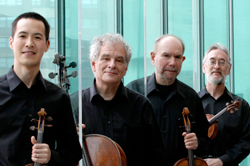by Daniel Hathaway
“Every
Smirnoff is in a position to know about that. Having played with the Juilliard since 1986, he moved from second to first fiddle in 1997 before withdrawing in 2008 to take up his new duties in Cleveland. Since then, there have been two more new first violinists. The latest, Joseph Lin, joined only last year and would be making his Cleveland debut on Tuesday evening. You have to imagine that Smirnoff and CIM’s chamber music festival had something to do with the large number of students who packed the house to the point where the ushers ran out of programs — a nice problem for a chamber music society to have.
Besides Lin, the current membership of the quartet includes second violinist Ronald Copes, violist Samuel Rhodes and cellist Joel Krosnick — and the quartet will become “new” yet again when Rhodes retires at the end of the season and Roger Tapping takes his place. While the quartet notes in print that the hallmarks of its distinctive sound include “clarity of structure, beauty of sound, purity of line and an extraordinary unanimity of purpose”, the four players seem quite free to cultivate their own individual timbres rather than trying slavishly to match each other’s tone quality. This results in a rich but lean ensemble sound that never becomes forced or plummy, and Lin fits into the concept perfectly.
The Juilliard Quartet set a challenging task both for themselves and the audience on December 4. Rather than follow a conventional programming plan (quartet from the classical period to start, more or less contemporary quartet in the middle, big romantic quartet to finish — something like the staple symphonic lineup of overture, concerto and symphony) the Juilliard scheduled two of Beethoven’s late quartets: No. 14 in c-sharp, op. 131 and No. 15 in a, op. 132. The intensity — and sometimes downright strangeness — of Beethoven’s writing, especially in the first of the two pieces, made for an enthralling evening of music.
The Juilliard began the fugue at the top of opus 131 with a sense of reverence that soon turned ecstatic along with Beethoven’s rising sequences. Though this is regarded as the most closely integrated of all of Beethoven’s quartets, as its seven movements progressed amid a dizzying variety of textures and thematic ideas ranging from the sublime to the silly, the note Beethoven wrote to his publisher accompanying the score began to sound more like truth than irony: “Put together from pilferings from this and that.” No matter how disjunct the musical content, the Juilliard delved deeply into each movement of the work, playing with total conviction amid some strange-sounding pizzicatos and brief moments of wavering intonation.
The op. 132 quartet is far more coherent as a listening experience if no less difficult for the players. Here the Juilliard’s playing was distinguished by evenness of transitions between moods and textures and a profound depth of emotion, especially in the affecting Heiliger Dankgesang Beethoven wrote after recovering from an illness. Joseph Lin was almost startling in his sudden burst of solo energy before the finale.
After those huge pieces, what on earth to choose for an encore? The Juilliard offered a lovely one, the slow movement from Haydn’s Quartet op. 20, no. 1, a meditative exploration of subtle harmonic twists and turns that ultimately and gently came home once again.
Published on ClevelandClassical.com December 11, 2012
Click here for a printable version of this article.



